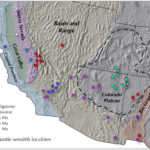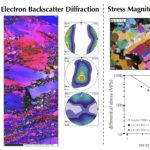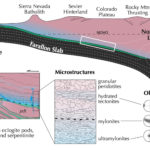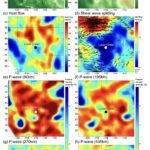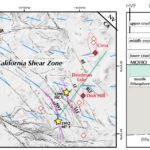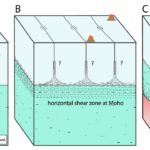Rheology of the Lithospheric Mantle Projects
We have several ongoing projects focused on the rheological and seismic properties of the lower crust and mantle lithosphere in continental regions. Our primary emphasis has been on xenoliths from beneath the western US, where we’ve been trying to answer the question: to what extent and by what mechanisms has the North American lithospheric mantle deformed during Cenozoic tectonic events?
This research is important to understanding:
- The preservation of early fabrics during subsequent deformational events, which is relevant to interpretations of seismic velocities and anisotropy in the western US and also to the general issue of the persistence of strain localization and plate boundaries through time.
- The contribution of the mantle lithosphere to continental deformation. For example: its viscosity, its ability to transmit stresses to the overlying crust, and the processes that weaken it.
We have thus far worked on three different xenolith suites: the Oligocene Navajo Volcanic field in the Four Corners region of the Colorado Plateau, the Lunar Crater volcanic field in Central Nevada and the Cima & Dish Hill volcanic fields in the Mojave desert of Eastern California (Fig. 1).
We use a range of analytical methods to interrogate these rocks: including X-ray CT scanning to identify foliations and lineations, Electron Backscatter Diffraction, major and trace element thermobarometers, water content measurements using Fourier Transform Infrared Spectroscopy & Second Ion Mass Spectrometry, and grain size analysis for paleopiezometry (Fig. 2). All three of the xenolith suites we’ve worked on are sourced from different pressure-temperature conditions and different tectonic environments— the one thing they all have in common is deformation to relatively high strains.
The Navajo Volcanic field includes mylonites and ultramylonites that have been deformed under hydrous, cold conditions. These were interpreted by Behr & Smith (2016) to represent shear within and above the contact between the subducting Farallon slab and the upper plate North American mantle lithosphere during Laramide flat-slab subduction (Fig. 3). The olivine lattice preferred orientations (known as B-type) within the mylonites are consistent with cold, wet conditions expected in a mantle wedge setting. Furthermore, the stress magnitudes recorded and the inferred effective viscosities in the peridotites are high enough to suggest that the Laramide flat-slab imparted enough shear stress to the upper plate to influence upper plate topography (and to perhaps induce the basement-cored uplifts that characterize the surface deformation during Laramide time).
Xenoliths from the Lunar Craters volcanic field record a very different history. This crater is very youthful (<1 Ma), and resides within the Basin & Range Province. Interestingly, the crater location coincides with a well-recognised P-wave anomaly oriented vertically with the upper mantle, interpreted by previous workers to represent lithospheric downwelling beneath the Great Basin. Our recent work in review (Dygert, Bernard & Behr, Great Basin mantle xenoliths record lithospheric downwelling beneath central Nevada) suggests that mylonitic textures within Lunar Crater mantle xenoliths reflect active deformation in the deep mantle lithosphere along the margin of this lithospheric drip.
The context of the Mojave mantle xenoliths is also unique, as the Cima and Dish Hill volcanic fields reside within the Eastern California Shear Zone which is part of the San Andreas Fault System. Our work there highlights several interesting aspects of lithospheric deformation. Behr & Hirth (2014) and Bernard & Behr (2017) demonstrated firstly, that the mantle is weak relative to the crust in this region, that deformation is localized in the mantle lithosphere beneath upper crustal faults, and that even where mantle and lower crustal fabrics are kinematically linked, their seismic fast axes may appear anticorrelated across the Moho.
- Figure 1. Mantle-xenolith-bearing volcanic centers in the western United States plotted on top of a map of main tectonic provinces.
- Figure 2. Examples of some of the methods used to analyze mantle xenoliths.
- Figure 3. Interpreted tectonic setting of mantle xenoliths sourced from the Navajo Volcanic Field in the central Colorado Plateau.
- Figure 4. Location of Lunar Crater compared to geophysical features of theBasin and Range. 448Elevation (a), elevation smoothed by averaging over one unit of latitude and longitude for each 449location (b), heat flow (c), shear wave splitting, whiskers show orientation and magnitude of 450individual observations (d), P-wave anomalies atdepths of 90km (e), 195km (f), 270km (g) and 451435km (h).
- Figure 5. (left) Map of southeastern California showing major faults and Cima and Deadman Lake volcanic fields (red dashed lines). Blue lines are upper mantle Pn anisotropy orientations and relative magnitudes [Buehler and Shearer, 2010]. Yellow stars identify epicenters of the 1992 Landers and 1999 Hector Mine earthquakes with earthquake ruptures shown in pink. Red diamonds mark the known localities of samples in this study, and white diamonds denote other xenolith-bearing localities. (right) Schematic cross section (green line on map) through the Cima and Deadman Lake fields, modified from Behr and Hirth [2014] based on petrological description of the Cima xenoliths from Wilshire [1990] and Cardon [2008], depth of the midcrustal/lower crust boundary from Romanyuk et al. [2007], depth of the Moho from Schulte-Pelkum et al. [2011] and Wilshire [1990], and depth of the LAB from Lekic and Romanowicz [2011]. HVF = Homestead Valley Fault; LLF = Lavic Lake Fault; LF = Ludlow Fault; BLF = Broadwell Lake Fault; BF = Baker Fault.
- Figure 6. Three possible mantle strain localization scenarios beneath strike-slip faults which could be supported by our xenolith observations: (a) ductile shear zones extending vertically into the mantle, (b) ductile shear zones extending through the lower crust and terminating as horizontal shearing concentrated around the Moho, and (c) strain localization due to asthenospheric upwelling.
